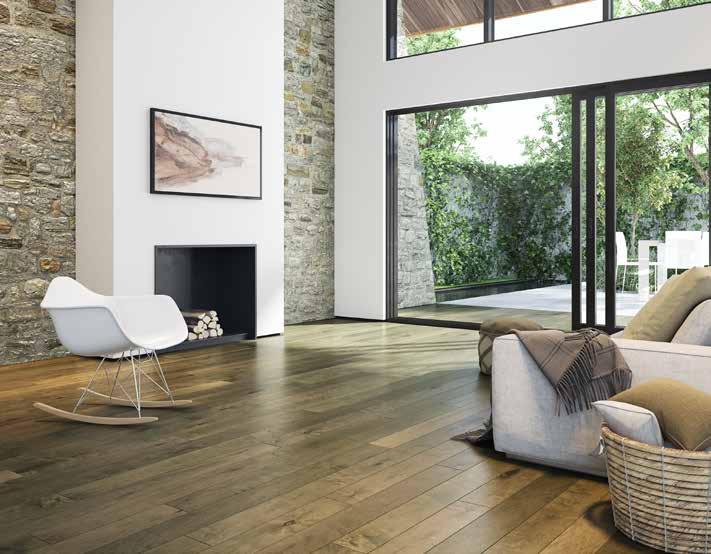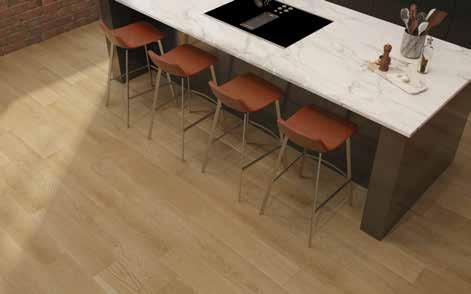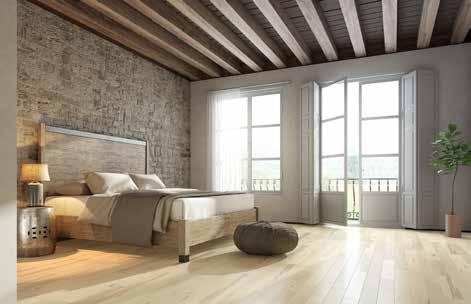
4 minute read
Into the Woods
Holistic living, public health lockdowns fuel new trends
By Francois D’Amours
Photos courtesy Preverco
Lifestyle has always been a big driver in design trends. What people consider important in their lives is often reflected in their home’s interior as it is key to the overall enjoyment of their surroundings. Over the last couple years, North American and European markets have experienced a growing interest in holistic living, with a focus on healthier and organic foods, exercise, nature and sustainability. At the same time, homes have evolved into more than just a place to live — they’ve become a sanctuary. The pandemic has amplified this as many people have been forced to work from home and remain inside for long periods of time. As a result, homeowners increasingly want environments that are clean, healthy, calm and cozy, and make them feel somewhat connected to nature.
Accordingly, the ultra-clean, minimalistic and modern designs that favour grey tones for flooring and have been all the rage in interior decor magazines for years are now often considered too cold and impersonal. They are gradually being replaced by a new mix of design styles, such as modern farmhouse and urban country. These trends feature warmer earth tones like ‘greige’ — a combination of grey and beige. Greige has become a new colour category in the flooring industry, too, as it’s easier to harmonize with dark or bold wall paint colours that are being used for dramatic effect.
THE REAL DEAL
Despite this shift in design trends, one thing that has remained constant is the quest for authenticity. Even more important to the flooring segment is the desire among shoppers for real wood floors over non-wood alternatives that have grown in market share. Consumers are saying goodbye to the high glosses and colours that hide the wood grain in favour of original-looking hardwood floors that cannot be confused in any way with cheaper, non-wood options.
Higher-end wood flooring manufacturers are applying new types of stains and finishes to make prefinished flooring look almost like bare wood while still offering the right level of protection. Next-generation reactive stains are also being used to bring rich tone variations that are almost impossible to replicate with anything else than a real wood top layer. These stains use the tannins, sap and other natural components in the wood to make every board and floor unique. Although some warm colour pigments are added to the floor surface, this does not compromise the true authentic feel of the wood underneath. Even if different markets and styles call for a knotty or clear look, demand for ‘the real deal without makeup’ still holds. In fact, this design story was in high demand in Europe well before it got to this side of the pond.
MIGHTY OAK
Among the multiple evolutions in the flooring marketplace, some have come from progressive changes while others have occurred immediately, influenced by pandemic lockdowns. Home offices now often double as work areas for parents and children taking part in remote learning. Pandemic isolation has also seen a booming demand for pets as people crave companionship. As a result, homeowners are increasingly calling for forgiving floors that are low maintenance, as well as wire brushed textures and matte finishes.
Oak is an amazingly versatile wood that is making a splash in wood species trends for all the right reasons. The wood grain depth and patterns of both white and red oak are the perfect fit for the new generation of stains, matte finishes and brushed textures. White oak is still king of the category, with subtler contrasts and an amber-like colour. The golden age of red oak was when browns and reddish colours were most popular; it is a lesser fit in the new greige era. However, new colouring processes and stains are coming to the rescue of the venerable red oak, making it more current. The heavy pressure on white oak resources should contribute to the resurgence of red oak — free of the unwanted pink look of the substrate and over-contrasted grain thanks to these advancements.


HOMEGROWN PRODUCTION
The domestic hardwood flooring industry is adapting to other fast-paced changes. The use of Baltic birch plywood as the core of engineered floors is facing uncertainty due to price volatility, import/export complexities and tariffs. Some manufacturing leaders in Canada have already removed these products. Others have announced they will walk away from using this type of plywood for their engineered floors in the near future. Instead, they will look to local resources not only for the top layer but also for the core of their products. This strategy would minimize their dependence on imported raw materials and associated risks, and bring to market a 100 per cent Canadian product. This is extremely appealing to the surge in consumers who prefer to buy local. A Canadian-made product is also perceived very positively south of the border. U.S. consumers are interested in purchasing North American products if homegrown ones aren’t available.
Francois D’Amours is director of marketing with Preverco. Located in Quebec City, Preverco is a 400-employee solid and engineered hardwood flooring company that sells across North America. Francois has worked in marketing leadership positions in the building product industry for more than 15 years.



